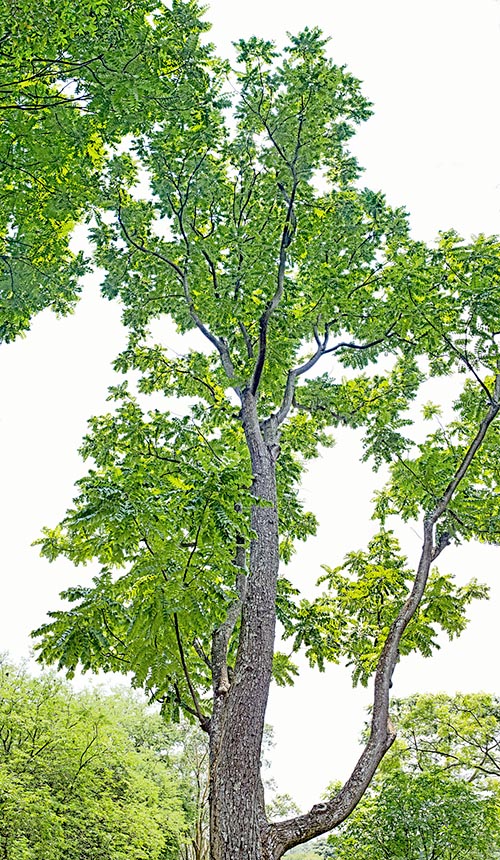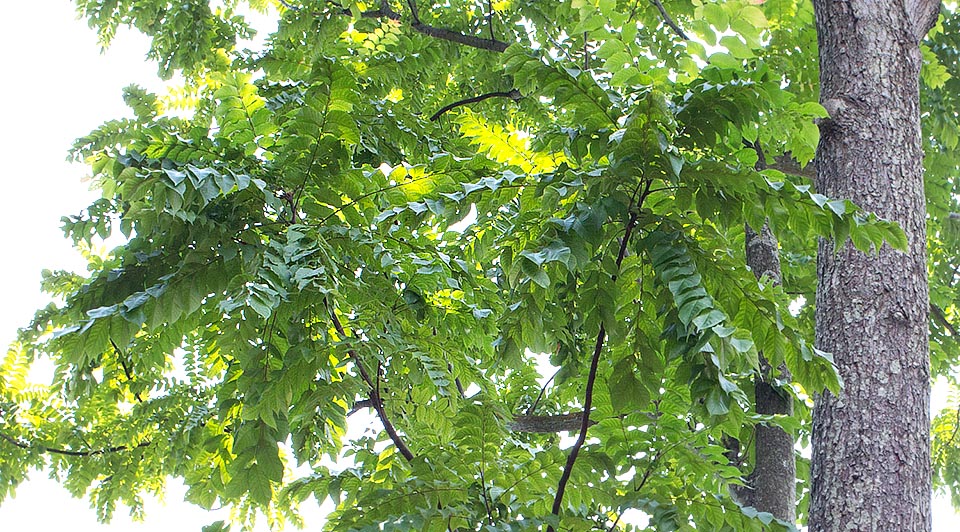Family : Meliaceae

Text © Pietro Puccio

English translation by Mario Beltramini

At home from India to China, Chukrasia tabularis is an even 35 m tall deciduous tree © Giuseppe Mazza
The name of the genus comes from the local name “chkrasi”; the name specific is the Latin adjective “tabularis, e” = flat, with reference to the seeds.
Common names: bastard-cedar, Burmese almondwood, chickrassy, Chittagong-wood, East Indian-mahogany, Indian redwood, white-cedar (English); voriong (Cambodian); boga poma, bogipoma, chkrasi, (malaveppu); ingol batu (Indonesia); mai nhom (Laos); surian batu, cherana puteh, repoh, suntang puteh (Malaysia); yinma (Myanmar); fak daap, waa-raa-yong, siat kaa (Thailandia); lat hoa, lat da dong, lat chun (Vietnam).
The Chukrasia tabularis A.Juss. (1830) is a deciduous tree up to about 35 m tall with erect trunk, of up to more than 1 m of diameter, provided at the base of tabular roots (flattened roots similar to buttresses) up to 1,5 m tall, and brown bark vertically fissured that with the time flakes in rectangular plaques and from which exudes a transparent yellow gum. The leaves, on a 4-7 cm long petiole, are pinnate or bipinnate, 20-50 cm long, with 10-20 pairs of ovate to oblong leaflets with pointed apex, asymmetrical, 4-15 cm long and 3-6 cm broad, of intense green colour, that close in the evening to open again the following morning.
Panicle inflorescences at the axil of the youngest leaves, 10-30 cm long, bearing unisexual or bisexual fragrant flowers with green, pink or red calyx, of about 0,3 cm of diameter, and 4-5 curved petals oblong-linear to spatulate, 1,2-1,8 cm long and 0,5 cm broad, of cream colour often suffused pink, glabrous or pubescent. Staminal cylindrical tube with 10 oblong anthers inserted at the apex, cylindrical style with trilobed stigma. The fruits are dehiscent woody capsules ovoid to oblong, 3-5 cm long and of 2-4 cm of diameter, yellowish to brown, containing up to more than 200 flat seeds, arranged in overlapping layers, provided in one extremity of brown membranous wing, oblong, 0,8-1 cm long and 0,5-1 cm broad, wing included; the seeds are dispersed by the wind. It usually reproduces by seed, in draining and aerated loam maintained humid, but without stagnations, at the temperature of 24-26 °C, with germination times from 1 to 6 weeks and first blooming by around the sixth year of age; it can reproduce also by cutting and grafting.
Fast growing species cultivable in the tropical and humid subtropical climate zones with high annual rainfall, preferably over the 1500 mm, when adult can resist to temperatures up to about -3 °C, provided exceptional and short lasting, with possible damage to the leaves. It requires an exposition in full sun, but in the juvenile phase when it can stand a slight shade, and deep fertile and well drained soils, not standing water stagnations, preferably calcareous. Introduced in many tropical and subtropical countries due to the wood of excellent quality, in some areas has escaped cultivation naturalizing and becoming in some cases invasive; it is also utilized as shade tree in the coffee plantations and at times in parks and gardens due to the ornamental foliage.

Fast growing in the rainy tropical regions but can stand short frosts. Elegant leaves, good wood and bark with medicinal properties © Giuseppe Mazza
Synonyms: Cedrela villosa Roxb. (1814); Chukrasia nimmonii Graham ex Wight (1831); Chukrasia trilocularis (G.Don) M.Roem. (1846); Chukrasia velutina M.Roem. (1846); Chukrasia tabularis var. velutina (M.Roem.) King (1895); Chukrasia velutina var. dongnaiensis Pierre (1897); Chukrasia velutina var. macrocarpa Pierre (1897); Chukrasia velutina var. microcarpa Pierre (1897); Chukrasia tabularis var. dongnaiensis (Pierre) Pellegr. (1911); Chukrasia tabularis var. macrocarpa (Pierre) Pellegr. (1911); Chukrasia tabularis var. microcarpa (Pierre) Pellegr. (1911); Dysoxylum esquirolii H.Lév. (1916); Chukrasia chickrassa (Roxb.) J.Schultze-Motel (1966).
→ To appreciate the biodiversity within the MELIACEAE family please click here.
